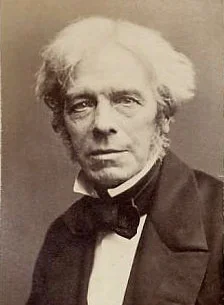Michael Faraday was born on 22 September 1791 to James Faraday and Margaret Hastwell in Newington Butts part of the London Borough of Southwark. His father, James, moved his family to London during 1790 from Outhgill in Westmorland, where he had been an apprentice blacksmith.
Michael was raised a devout Christian and received a very basic education as a child.
In 1805 he became an apprentice to a local bookbinder and bookseller and during his seven-year apprenticeship read a great many books, He also became a member of the City Philosophical Society where he attended lectures about various scientific topics, developing a firm interest in science, and especially in electricity.
In his early twenties, Faraday attended lectures by the eminent English chemist Humphry Davy of the Royal Institution and the Royal Society. Faraday sent Davy a 300-page book based on notes that he had taken during these lectures. Davy was clearly impressed as he replied immediately to Faraday in a very favourable manner.
In 1813 Davy injured himself during a chemical experiment which impacted on his eyesight. He was determined to have Faraday as his assistant. Having been asked to find a new Assistant for the Royal Institution Davy decided to employ Faraday in the role, which he did on the 1st of March that year.
In 1821, Davy used the electromagnetic discovery of Hans Christian Ørsted to attempt the construction of an electric motor but failed. Faraday however, having discussed this work with Davy, designed and built what became known as the “Homopolar motor”. Unfortunately, he published his findings and designs without the acknowledgment of Davy which caused a fall out between himself and his mentor.
In recognition of his work and discoveries, in 1824 Faraday became a Fellow of the Royal Society. The following year he became Director of the Laboratory of the Royal Institution.
Faraday gave a series of Christmas lectures for young people, at the Royal Institution in London, between 1827 and 1860. This started the tradition of Royal Institute Christmas Lectures that continues up to the present day.
In 1848 Faraday was awarded a grace and favour house free of all expense in Hampton Court. Faraday retired to live there in 1858 and died there on 25 August 1867. He was 75. Having declined the offer of being buried in Westminster Abbey he was instead buried in Highgate Cemetery and a plaque was placed in his memory in Westminster Abbey.
Aside from his legacy as the father of the electric motor, Faraday’s achievements also include:
- Discovering chemical substances such as benzene.
- Successfully liquefying several gases.
- Producing several new kinds of glass for optical purposes.
- Finding the rotation of the plane of polarisation of light.
- Discovering electromagnetic induction
- Demonstrating that a changing magnetic field produces an electric field.
- Formulating the laws of electrolysis,
- Constructing the electric dynamo,
- Popularizing the terminology of William Whewell such as anode, cathode, electrode, and ion.
- Suggesting improvements to the lenses of lighthouses.
- Contributing to mine safety by recognising and demonstrating the dangers of coal dust in explosions.
- Providing a way to visualize electric and magnetic fields using lines of flux.
- Assisting in the planning of the Great Exhibition.
- Raising awareness of the dangers caused by the pollution of the Thames.
- Raising awareness of the dangers of air pollution.
Indeed, Rutherford said of Michael Faraday – “When we consider the magnitude and extent of his discoveries and their influence on the progress of science and of industry, there is no honour too great to pay to the memory of Faraday, one of the greatest scientific discoverers of all time.”
The SI unit of capacitance was named the Farad in his honour.

Michael Faraday

Leave a Reply